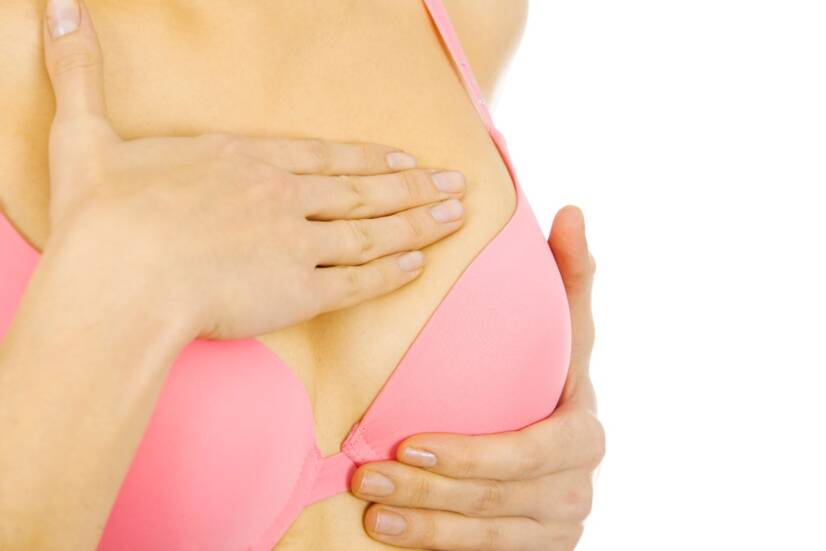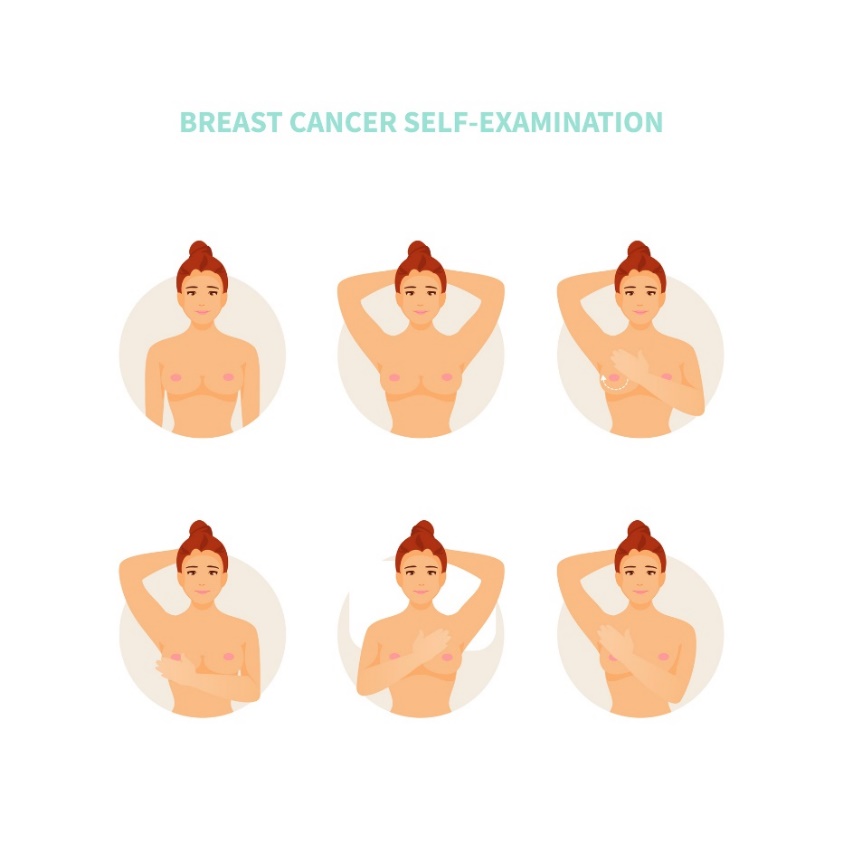- ROZTOČIL, Aleš and Pavel BARTOŠ. Modern Gynaecology. Prague: Grada, 2011. ISBN 978-80-247-2832-2
- KOLÁŘOVÁ, Milena. Painful menstruation I. Prague: Triton, 2003.
- fmed.uniba.sk - Basics of Mammology. Kamil Pohlodek. Comenius University Bratislava
- pubmed.ncbi.nlm.nih.gov - Evaluation and management of breast pain. Robin L Smith, Sandhya Pruthi, Lorraine A Fitzpatrick
- ncbi.nlm.nih.gov - Mastalgia. Muhammad T. Tahir; Shafeek Shamsudeen
Breast pain during and outside the menstrual cycle? Causes and solutions

Breast pain is both a symptom of a woman's cycle and a signal of a disorder. When to worry and when not to worry?
Article content
Breast pain can be a physiological manifestation of a woman's cycle, but it can also be a signal of a potential disorder. Which pains should we not worry about and which ones should we watch out for? What are the possible causes of breast pain and their solutions?
Breasts in a nutshell
The breast (mamma) is a paired glandular organ located approximately at the level of the 3rd-4th rib above the pectoralis major muscle (musculus pectoralis major). The breast are located in the centre of the breast and the nipple.
This area is more pigmented and has small bumps on its surface, which are the ducts of the mammary glands.
The basic internal structure of the breast is the mammary gland (glandula), which is composed of a large number of lobules. From each lobule, a lobular milk duct converges and enters the nipple.
The mammary gland is surrounded by fatty tissue, which determines the size and overall shape of the breast.

Breast pain
Breast pain is a common unwanted symptom during the menstrual cycle, but it can occur outside of it as well. Usually, it is a physiological manifestation of changing hormones and sometimes, on the other hand, the pain is a signal for a certain disorder or disease in the body.
Breast pain is technically called mastodynia/mastalgia and is a common health problem for women of all ages.
Mild pain, increased tightness and tenderness in the breasts is common during certain phases of the female cycle. This is especially a symptom in the context of PMS (premenstrual syndrome) or during the period of ovulation.
However, it is always advisable to see a gynaecologist when there is excessive or non-specific pain.
With the help of a specialist examination (palpation, ultrasound or mammography) it is possible to determine the cause of the pain and thus rule out potentially dangerous breast diagnoses.
Breast pain during the menstrual cycle
Menstruation and premenstrual syndrome
Hormonal changes in estrogen, progesterone and prolactin are behind breast pain before the start of the menstrual cycle. This characteristic pain is also referred to as cyclical mastalgia.
Increased estrogen during ovulation before menstruation decreases again. There is also a slight increase in the milk ducts and glands inside the breast due to changes in prolactin levels.
Most women experience pain in the upper and side of the breasts, but increased tenderness can also be noted in the armpits.
Other associated symptoms of PMS are lower abdominal pain, nausea, headaches, fatigue or emotional fluctuations.
Manifestations of breast pain during menstruation:
- Increased sensitivity of the breasts to touch
- Tenderness in the armpit area
- Slight enlargement and swelling of the breasts
- Increased pressure and tightness in the breasts
Ovulation and fertile days
Due to changing hormone levels, there may be increased breast tenderness and soreness during ovulation and the fertile days of the cycle (fertile window).
This painful phenomenon is mainly caused by the increase in estrogen after the follicle (envelope) of the egg in the ovary has ruptured.
The most fertile period of the cycle may therefore be accompanied by increased breast tightness and tenderness.
Menopause and menopause
In some cases, women also experience breast pain during the menopause, particularly in connection with menopausal syndrome, which is characterised by specific symptoms such as hot flushes, headaches, insomnia or weight gain.
The decline in hormones causes the function of the mammary gland, which produces breast milk, to disappear. The mammary gland is replaced by fat. Thus, increased breast tenderness and mild breast tenderness or atrophic changes in the mammary gland may also occur.
Older age is a risk factor for breast cancer and therefore regular check-up with a gynaecologist is necessary.
Breast pain outside the menstrual cycle
When a woman experiences breast pain outside her cycle in the sense of ovulation, menstrual bleeding or breastfeeding, early diagnosis and treatment is necessary.
It may be a muscle strain during exercise, swollen lymph nodes, cysts or also a signal of a more serious disease such as breast cancer.
Pain after exercise
In the case of excessive physical activity involving the pectoral muscles (musculus pectoralis major et minor), the muscles may be overstretched. In some cases, the muscle may be stretched and the muscle fibres damaged.
This is more likely to be muscular pain affecting the area of the armpit where the pectoralis muscle attaches. However, if the pain persists, it is necessary to see a doctor.
Inappropriate choice of bra
If a woman has been using the wrong size and type of bra for a long time, it is possible for her to develop mild breast pain. This is particularly the case with small and tight bras with a push-up effect, which compress and put excessive pressure on the breast tissue when worn.
Usually in the evening after removing the bra, women experience increased breast tenderness. However, in the case of non-specific pain, it is necessary to consult a doctor about the cause of the pain.
Pain in benign breast masses
During the course of her life, a woman may feel a lump, lump or hardened part of the breast tissue. In most cases, this is a benign mass that needs to be monitored to determine the type of treatment.
In some cases, however, it may be a manifestation of a more serious disease or breast cancer.
In most cases, the presence of a lump is associated with pain and tenderness in the breast area. A diagnosis by a specialist gynaecologist is always necessary.
Acyst in the breast is a cavity (sac) filled with fluid that can vary in size. It is a benign mass. In most cases, the cyst will absorb or shrink over time.
If a large number of small cysts form, it is a cystic mastopathy. Doctors usually observe the cyst, sometimes performing a puncture (suctioning out the fluid).
The etiology of cysts in the breast is not well known, but may be related to hormonal changes and imbalances within the menstrual cycle and the age of the woman.
Fibroadenoma is the most common benign tumour. It usually occurs in women at a younger age, most commonly between 20 and 35 years of age. The size of the tumour is approximately 2 to 4 cm.
The surface is firm and smooth to the touch and the mass is precisely circumscribed to the surrounding breast tissue. It is relatively mobile. Its growth and enlargement are mainly influenced by hormonal changes, pregnancy, lactation or the menopause.
The adenoma should be monitored. Treatment is determined by the gynaecologist.
An abscess is a rare benign mass that can be palpated as a lump. It is an abnormal growth of glandular tissue. In most cases, the entire breast is inflamed and tender. Abscesses are regularly monitored by a doctor. It is particularly common in breastfeeding women.
A lipoma is a benign mass arising from the fat cells of the breast. It is semi-solid and relatively well circumscribed. A papilloma is a benign mass within the milk ducts. In most cases it is associated with a pathological bloody discharge from the nipple of the breast.
Pain in malignant formation of the breast
Breast pain is one of the possible symptoms of breast cancer. However, it is not the only one, as other symptoms are also present in cancer - enlarging lump, enlarged lymph nodes in the armpit, excessive fatigue, weight loss and many others.
However, severe mastopathy can also mean an increased risk of breast cancer. That's why it's important to keep regular home breast self-exams and preventive checkups with your gynecologist.
If the disease is diagnosed at an early stage, there is the best chance of curing it.
Due to the painfulness and possible presence of a wide range of formations in the breast, diagnosis by a specialist gynaecologist is always necessary.
Breast pain in pregnancy
Excessive breast tenderness is one of the first signals women notice in pregnancy. Breast tenderness is a possible occurrence during a woman's pregnancy.
Most often, mild pain is caused by hormonal changes, but it can be associated with a specific problem and malfunction of the breast. In most cases, however, it is a problem with breastfeeding and milk ducts.
Consultation with a doctor and regular health checks are always necessary.
The inflammatory process in the mammary gland is professionally called mastitis. It can manifest itself even outside pregnancy and breastfeeding.
Its cause is insufficient emptying of the milk ducts during breastfeeding or injury to the nipple, which spreads the infection to the mammary gland. Symptoms include breast tenderness and hardness, enlarged lymph nodes in the armpit, increased temperature or fatigue.
Treatment is determined by the examining physician.
Hyperprolactinaemia is an excessive increase in prolactin production and occurs mainly during the breastfeeding period. The main symptom is breast pain and milky discharge from the nipples. Treatment consists of lowering the level of the hormone prolactin.
The exact form of treatment is determined by the examining physician.
Blocked milk ducts are mainly caused by thick milk flowing out of the mammary gland through the milk ducts. The cause may be insufficient emptying of the milk ducts.
The manifestation is tenderness and sensitivity of the breast, inflammatory process of the breast, increased temperature or the formation of a small lump. The solution is gentle breast massage, warm compresses and more frequent breastfeeding or pumping.
However, the exact type of treatment and drug therapy will be determined by the examining physician.
Prevention of breast pain
The basic prevention of breast pain is regular self-examination of the breasts at home and regular preventive examinations by a gynaecologist.
If you experience non-specific, sudden or prolonged pain, it is advisable to contact your gynaecologist urgently.
Choosing the right bra is also important. It should have the right cup size and circumference and should not put excessive pressure on the breasts or provide insufficient support.
Natural help in terms of a good lifestyle, a complete balanced diet, supplementation of necessary vitamins (especially B vitamins), minerals or natural help from herbs is also advisable.
It is also advisable to consult a doctor when taking herbal supplements. Natural help from extracts of 'feminine' herbs and herbal teas can be used in connection with breast pain in premenstrual syndrome.

Interesting resources










